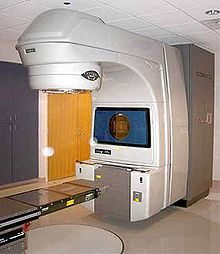Electron accelerator
An electron accelerator is a technical device that sets free electrons in motion very quickly.
Principle and types

Electrons released by a hot cathode are first accelerated with an electron gun in a stationary electric field. Then they are further accelerated by alternating electrical fields, either on a straight path ( linear accelerator ) or on a more or less ring-shaped path, which is achieved by deflection in magnetic fields ( betatron , microtron , synchrotron , rhodotron ).
Electrons can easily be brought to speeds close to the speed of light . After running through a voltage of 80 kV (kilovolts) they have 50% of the speed of light. At such high speeds, relativistic mechanics must be used for the description instead of classical mechanics ; after her z. For example, the kinetic energy of the electrons will still increase even if their speed hardly increases.
Accelerators that work with magnetic deflection force the electrons on curved paths. This creates synchrotron radiation , which on the one hand removes energy from the electrons (linear accelerators are therefore better used for very high energies), but on the other hand can be used as a highly brilliant source of ultraviolet and X-ray radiation .
In order to be able to use the electron beam outside of the accelerator's vacuum , it has to pass through an exit window. This can consist, for example, of a titanium foil a few micrometers thick; but there are also aerodynamic windows .
The energy of the electrons determines their depth of penetration into the material.
A distinction is made between electron accelerators used industrially
- Low-energy electron accelerator acceleration energies from 70 keV to 300 keV,
- Medium energy accelerator for 500 keV to 3 MeV ,
- High energy accelerator from 3 MeV up to 10 MeV.
For research purposes and for the targeted generation of synchrotron radiation, energies in the GeV range are used.
application areas
Electron accelerators are used in industry and medicine for various applications, for example
- Electron beam welding
- Radiographic test on thick-walled components
- Cross-linking of polymers (rubber and plastics): foils, pipes, cable insulation, lacquers, paints, adhesives, resins
- Material analysis
- for the free electron laser
- Sterilization of water, exhaust air, medical consumables, outside of Europe also food
- Radiation therapy against cancer, directly with electron beams or indirectly by bombarding a target for X-rays
Plant examples
- The accelerator with the world's highest electron energy to date, almost 50 GeV, is the linear accelerator of the SLAC in California.
- The German Electron Synchrotron ( DESY ) in Hamburg, one of the world's first facilities for research with electrons in the GeV energy range, started operations in 1964.
- Today (2015) there are systems built especially for the generation of synchrotron radiation worldwide. In Europe z. B. to call
- Smaller electron accelerators, for example, work in around 25 sterilization plants around the world, including in Kremsmünster (Austria) (sterilization of medical products), in California and Texas (food sterilization), four in Germany and one in Switzerland.
literature
- Hanno Krieger: Radiation sources for technology and medicine. 2., revised. and exp. Edition. Springer Spectrum, Wiesbaden 2013, ISBN 978-3-658-00589-4 .
- Samy Hanna: RF Linear Accelerators for Medical and Industrial Applications. Artech House, Boston MA et al. 2012, ISBN 978-1-60807-090-9 .
